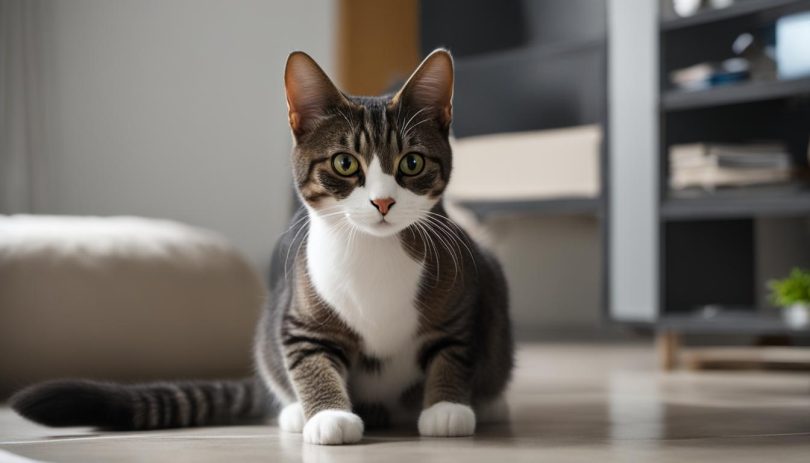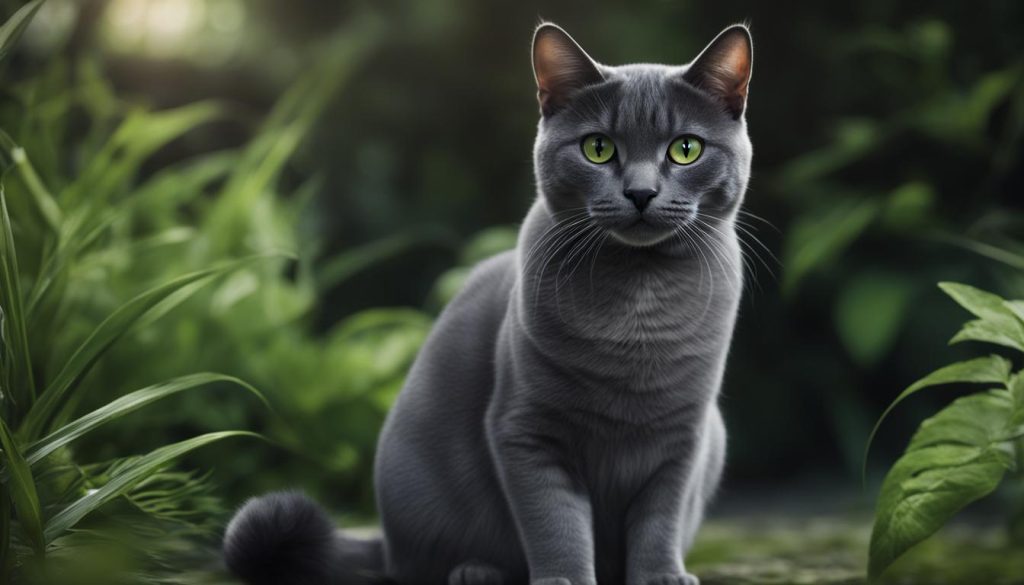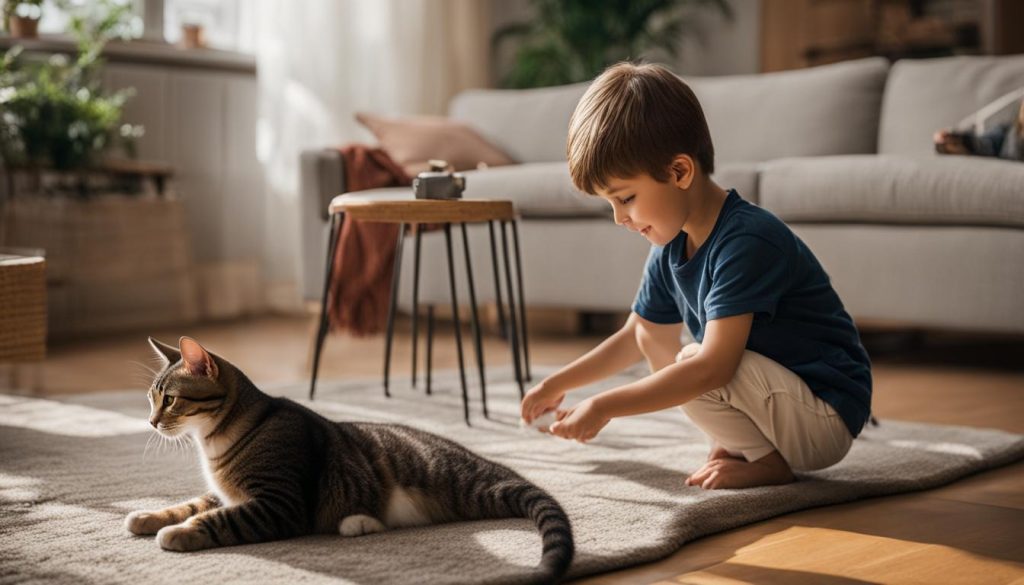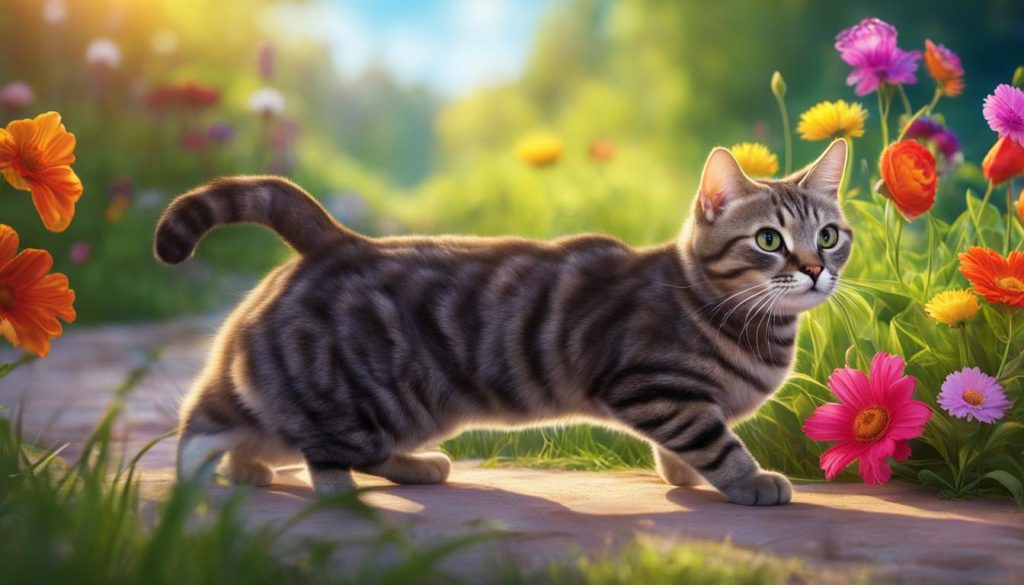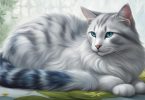Are you curious about the size of European Shorthair cats? Well, you’ve come to the right place! In this article, I’ll provide you with an overview of the European Shorthair size, along with other important details about this delightful breed. So, let’s dive right in!
The European Shorthair is a medium-sized cat breed, known for its friendly temperament and sociable nature. These cats have an average height ranging from 9 to 11 inches and weigh between 12 to 15 pounds. With a lifespan of 15 to 20 years, they can be wonderful companions for families, children, seniors, and even dogs. Their intelligence and playfulness make them a joy to be around.
European Shorthairs have a short coat that comes in various colors. They are typically active cats, with a moderate level of playfulness. Their sleek and shiny coat requires minimal grooming, making them a low-maintenance breed.
Throughout this article, we’ll delve deeper into the physical characteristics, temperament, living environment, compatibility with children and other pets, grooming needs, intelligence, health, and origins of European Shorthair cats. By the end, you’ll have gained a comprehensive understanding of this remarkable breed.
Key Takeaways:
- The European Shorthair is a medium-sized cat breed with an average height of 9 to 11 inches.
- These cats weigh between 12 to 15 pounds.
- They have a lifespan of 15 to 20 years and are known for their friendly and sociable temperament.
- European Shorthairs have a short, low-maintenance coat and come in various colors.
- They make excellent companions for families, children, and even other pets.
Physical Characteristics of European Shorthair Cats
European Shorthair cats are medium-sized cats with a firm build. They typically weigh between 12 and 15 pounds. They have rounded faces and bodies, and their height ranges from 9 to 11 inches. Their vibrant eyes come in shades of blue, green, or amber, and they can also have odd-eyed coloration, with one blue eye and one amber or green eye. Compared to other shorthair breeds like the British Shorthair and American Shorthair, the European Shorthair has a more muscular and stockier build.
Physical Characteristics of European Shorthair Cats:
| Characteristic | Description |
|---|---|
| Weight | 12-15 pounds |
| Height | 9-11 inches |
| Eye Color | Blue, green, amber |
| Coat Length | Short |
The European Shorthair is a well-proportioned cat with a solid bone structure. Their muscular build gives them a stocky appearance, distinguishing them from other shorthair breeds. They have a medium-sized head with a rounded shape and ears that are medium in size and set wide apart. Their short coat is smooth and sleek, requiring minimal grooming. The European Shorthair’s physical attributes make them a striking and sturdy cat breed.
With their average size and robust physique, European Shorthair cats make a strong impression. Their muscular build and distinctive eye colors add to their unique personality. Whether sitting or playing, their physical characteristics showcase their strength and agility. These cats are a beautiful addition to any household.
Coat and Colors of European Shorthair Cats
The coat of European Shorthair cats is short and characterized by its sleek and shiny appearance. The dense and straight hair requires minimal grooming and only needs to be brushed once a week to keep it smooth and lustrous. These cats are meticulous self-groomers, which contributes to their low-maintenance coat. Due to their short hair, they are moderate shedders, making them suitable for individuals with allergies or those who prefer a tidy home environment.
European Shorthair cats come in a wide range of colors and patterns. They can be found in solid colors such as black, blue, chocolate, cinnamon, cream, fawn, lavender, lilac, red, and white. The variety of colors allows potential owners to choose a cat that matches their preference and style. Whether you prefer a sleek black cat or an elegant cream-colored feline, European Shorthairs offer a diverse array of coat colors to suit every taste.
In addition to solid colors, European Shorthair cats can also exhibit various patterns, including tabby, tortoiseshell, and calico. The combination of different colors and patterns creates unique and eye-catching coat designs. Whether it’s the classic tabby stripes or the striking orange and black patches of a tortoiseshell cat, European Shorthairs showcase the beauty and diversity of feline coat patterns.
Table: Coat Colors and Patterns of European Shorthair Cats
| Coat Colors | Coat Patterns |
|---|---|
| Black | Tabby |
| Blue | Tortoiseshell |
| Chocolate | Calico |
| Cinnamon | Bi-color |
| Cream | Smoke |
| Fawn | Colorpoint |
| Lavender | Van |
| Lilac | |
| Red | |
| White |
With their wide range of coat colors and patterns, European Shorthair cats are not only known for their friendly and sociable nature but also for their striking and beautiful appearance. Their coat adds to their charm and uniqueness, making them delightful companions for any cat lover.
Temperament and Personality of European Shorthair Cats
European Shorthair cats are known for their exceptional temperament and sociability. They have a friendly and tolerant nature, making them great companions for individuals and families alike. These cats are intelligent and adaptable, and they quickly establish strong bonds with their human companions.
One of the remarkable traits of European Shorthair cats is their high level of sociability. They enjoy being part of a family and are typically good with children, other pets, and even seniors. Their friendly and outgoing nature makes them a popular choice for households with multiple animals or where there are frequent visitors.
European Shorthairs are also known for their playful nature. They have a moderate level of playfulness and thrive on mental and physical stimulation. Interactive toys and puzzle games are excellent ways to keep them entertained and mentally engaged. Additionally, their lineage as barn cats contributes to their natural hunting instincts, making them excellent mousers.
Intelligence is another prominent characteristic of European Shorthair cats. They are quick learners and enjoy mental challenges. This intelligence, combined with their sociable nature, allows them to adapt well to different environments and situations. However, it’s important to note that individual temperaments may vary due to their diverse genetic background, so each cat may have its own unique personality.
EuroCat Quote:
“European Shorthairs are the perfect blend of sociability, playfulness, and intelligence. They bring joy and companionship to any home. Their adaptability and friendly nature make them a wonderful choice for families and pet lovers.”
| Trait | Description |
|---|---|
| Sociability | Highly sociable with good compatibility with children, other pets, and seniors. |
| Playfulness | Moderately playful, enjoys interactive toys and games. |
| Intelligence | Quick learners, enjoy mental challenges. |
| Variability | Individual temperament may vary due to diverse genetic background. |
Living Environment and Exercise for European Shorthair Cats
Creating an ideal living environment for your European Shorthair cat is essential to ensure their well-being and happiness. These cats thrive in calm and quiet surroundings, so it’s important to minimize loud noises and sudden disruptions in their living space. Providing hiding places, such as cat trees or cozy blankets, can help your European Shorthair feel safe and secure when they need some alone time.
While European Shorthairs are mainly indoor cats, they have a natural instinct to explore the outdoors. Offering them access to a secure outdoor enclosure or a catio can fulfill their desire for fresh air and outdoor stimulation while keeping them safe from potential dangers like traffic or other animals.
European Shorthair cats have an active nature and require regular exercise to keep them mentally and physically stimulated. Engaging them in playtime sessions with interactive toys, feather wands, or puzzle feeders can help satisfy their hunting instincts and provide mental enrichment. Allocating time for daily play sessions and providing vertical spaces for climbing and jumping can help keep them fit and engaged.
Exercise Recommendations for European Shorthair Cats:
- Engage in interactive play sessions for at least 15-20 minutes daily.
- Provide toys that encourage mental stimulation, such as treat puzzles or interactive balls.
- Set up vertical spaces, like cat trees or shelves, to promote climbing and jumping.
- Consider using a harness and leash for supervised outdoor walks.
Remember, each European Shorthair cat is unique, and their exercise needs may vary. Pay attention to their individual preferences and adjust the exercise routine accordingly. Regular playtime and environmental enrichment are key to keeping your European Shorthair happy and healthy.
| Living Environment | Exercise |
|---|---|
| Prefer calm and quiet surroundings | Engage in daily interactive play sessions |
| May require hiding places to feel secure | Provide toys that encourage mental stimulation |
| Access to secure outdoor enclosure or catio | Set up vertical spaces for climbing and jumping |
| Consider using a harness and leash for supervised outdoor walks |
European Shorthair Compatibility Tips:
- Supervise interactions between children and cats to ensure gentle and respectful behavior.
- Introduce European Shorthair cats to other pets gradually and under supervised conditions.
- Consider the individual temperaments of all pets involved to ensure compatibility.
- Provide equal attention and affection to all pets to prevent jealousy.
Grooming and Maintenance for European Shorthair Cats
Keeping your European Shorthair cat well-groomed is a breeze, thanks to their short and low-maintenance coat. These cats are meticulous self-groomers and only require weekly brushing to keep their coat smooth and shiny. Bathing is infrequent, as their natural cleanliness ensures they stay fresh. However, regular nail trimming and ear cleaning should be part of their grooming routine to maintain their overall health.
European Shorthairs are moderate shedders, so regular brushing helps minimize shedding and keeps their coat in top condition. Use a soft brush or grooming glove to gentle remove loose hairs and keep their coat free from tangles and mats. During the grooming process, take the opportunity to inspect their skin for any signs of irritation, parasites, or irregularities.
“European Shorthair cats have a short, low-maintenance coat that only requires weekly brushing to keep it smooth and shiny.”
As with all cats, dental care is an important aspect of their overall grooming routine. Brushing your European Shorthair cat’s teeth regularly can help prevent dental disease and maintain their oral hygiene. Additionally, providing them with appropriate scratching posts or boards can help keep their claws healthy and prevent them from scratching furniture.
Grooming Needs Summary
To summarize, European Shorthair cats have minimal grooming needs compared to other breeds. Here are the key points:
- Weekly brushing to keep their coat smooth and shiny
- Infrequent bathing due to their natural cleanliness
- Regular nail trimming and ear cleaning
- Proper dental care and oral hygiene
- Provide adequate scratching options for claw maintenance
Grooming Supplies Checklist
Here is a checklist of essential grooming supplies for your European Shorthair cat:
- Gentle brush or grooming glove for weekly brushing
- Cat-friendly shampoo and conditioner for occasional bathing
- Nail clippers or a nail grinder for regular nail trimming
- Cotton balls and cat-friendly ear cleaning solution for ear cleaning
- Cat toothbrush and toothpaste for regular dental care
- Scratching posts or boards for claw maintenance
| Grooming Needs | Description |
|---|---|
| Brushing | Weekly brushing to maintain a smooth and shiny coat |
| Bathing | Infrequent bathing due to natural cleanliness |
| Nail Trimming | Regular trimming to maintain claw health |
| Ear Cleaning | Regular cleaning to prevent wax build-up and infections |
| Dental Care | Regular brushing to maintain oral hygiene |
| Claw Maintenance | Providing appropriate scratching options |
Training and Intelligence of European Shorthair Cats
Training European Shorthair cats can be a rewarding experience. These intelligent felines are quick learners and respond well to positive reinforcement techniques. To effectively train your European Shorthair, it’s important to understand their unique characteristics and temperament.
European Shorthairs are known for their intelligence and problem-solving abilities. They have a natural curiosity and love to explore their surroundings. Providing them with puzzle toys and interactive games can help keep their minds stimulated and prevent boredom. These activities also tap into their hunting instincts, which can be highly entertaining to watch.
When it comes to training, consistency and patience are key. Start with basic commands like “sit” and “come” using treats as rewards. Be sure to use positive reinforcement, such as praise and treats, to encourage desired behaviors. Avoid punishment or negative reinforcement, as it can cause stress and hinder the training process.
Some European Shorthair cats can be resistant to training or have a more independent streak. In such cases, it’s important to find training methods that work best for your individual cat. Some cats may respond better to clicker training, while others may prefer verbal cues or hand signals. Experiment with different techniques to find what suits your cat’s learning style.
| Training Tips for European Shorthair Cats |
|---|
| Use positive reinforcement techniques |
| Be patient and consistent |
| Start with basic commands and gradually progress |
| Provide mental stimulation through interactive toys and games |
| Respect your cat’s individuality and adjust training methods accordingly |
Remember, training should be a bonding experience between you and your European Shorthair. Enjoy the process of teaching your cat new skills and watch as their intelligence shines through. With time, patience, and positive reinforcement, you can help your European Shorthair become a well-trained and well-behaved companion.
Health and Lifespan of European Shorthair Cats
When it comes to the health and lifespan of European Shorthair cats, there is good news – this breed generally enjoys a long lifespan of 15 to 20 years. However, like all cats, they may be prone to certain genetic predispositions that can affect their health. Regular veterinary check-ups and screenings are important to ensure their overall well-being.
Some of the potential health issues that European Shorthair cats may be susceptible to include polycystic kidney disease, brachycephalic syndrome, and heart disease. These conditions can vary in severity, and it’s essential to monitor your cat’s health and seek prompt veterinary care if any signs of pain or discomfort arise.
To provide a visual representation of their genetic predispositions and potential health concerns, here is a comprehensive table:
| Genetic Predispositions | Potential Health Issues |
|---|---|
| Polycystic Kidney Disease (PKD) | Kidney problems, urinary tract infections |
| Brachycephalic Syndrome | Respiratory difficulties, snoring, eye and skin issues |
| Heart Disease | Hypertrophic cardiomyopathy, congestive heart failure |
It’s important to note that not all European Shorthair cats will develop these health issues, and the prevalence can vary among individuals. Regular veterinary care, a balanced diet, and a healthy lifestyle can help mitigate and manage potential health concerns.
By staying proactive and attentive to the specific needs of your European Shorthair, you can help ensure that they live a long, healthy, and happy life.
The History and Origins of European Shorthair Cats
European Shorthair cats have a fascinating history that can be traced back to ancient Rome. These cats were highly valued for their hunting skills and were often found in barns and shops throughout Europe. They were known for their ability to control rodent populations, making them cherished companions for farmers and merchants. The European Shorthair breed as we know it today has its origins in Sweden in the 20th century, where efforts were made to establish a breed standard and preserve the unique features of these beloved cats.
The European Shorthair breed standard defines the specific characteristics that distinguish these cats from other breeds. They are medium-sized cats with a firm build and a stockier, more muscular appearance compared to other shorthair breeds. The breed standard also includes traits such as a short coat of straight, thick hair, vibrant eyes in various colors, and a friendly and sociable temperament. Breeders have worked diligently to maintain these distinct and desirable features, ensuring that European Shorthair cats continue to embody their unique heritage.
While European Shorthairs have a long and storied history, they remain relatively rare in certain parts of the world. In Europe, they are beloved and cherished as a national cat breed in Finland. However, outside of Europe, their presence may be less common. Despite this, their rich and diverse history has left a lasting impact, and their unique characteristics continue to captivate cat enthusiasts around the globe.
Fun Facts and Trivia about European Shorthair Cats
European Shorthair cats are fascinating creatures with a rich history and unique traits. Here are some interesting facts and trivia about these beloved feline companions.
“European Shorthair cats are sometimes referred to by different nicknames, including Celtic Shorthair and Bondkatt, which means ‘farm cat’ in Swedish.”
These cats have earned the nickname “Celtic Shorthair” due to their connection to ancient cultures, particularly the Celts. They were highly valued for their hunting skills and were often found on farms across Europe. Their adeptness at catching mice made them essential in maintaining a healthy rodent-free environment.
Another interesting fact is that European Shorthair cats are the national breed of Finland. They hold a special place in the hearts of the Finnish people, who consider them a symbol of their country and its rural heritage.
In terms of appearance, European Shorthair cats come in a variety of colors and patterns, making each cat unique. Their coat colors can range from solid black to tortoiseshell, tabby, or even calico. With their vibrant eyes and distinctive coat patterns, European Shorthair cats are truly captivating to behold.
| Fun Facts | Trivia |
|---|---|
| European Shorthair cats are sometimes referred to as Celtic Shorthair or Bondkatt. | European Shorthair cats are the national breed of Finland. |
| They were highly valued for their hunting skills and were often found on farms across Europe. | European Shorthair cats come in a variety of colors and patterns. |
| Their coat colors can range from solid black to tortoiseshell, tabby, or even calico. |
European Shorthair cats are truly remarkable companions, with their rich history, diverse coat colors, and unique characteristics. Whether you’re captivated by their hunting skills, intrigued by their nicknames, or simply taken by their elegance, these cats are sure to bring joy and charm to any home.
Conclusion
The European Shorthair is a unique and versatile cat breed with a medium size and a gentle temperament. They make great companions for families, including children and other pets. Their low-maintenance grooming needs and adaptability to different environments make them suitable for various households.
European Shorthair cats have a long lifespan and generally enjoy good health, although regular veterinary care is essential for their well-being. With their rich history and distinct physical characteristics, these cats bring a touch of European charm wherever they go.
Whether you’re looking for an intelligent and sociable cat or a playful and loyal companion, the European Shorthair is a fantastic choice. Their friendly nature and ability to get along with other pets and children make them a valuable addition to any family. With their short coat and minimal grooming requirements, they are easy to care for and fit well into different living environments.
So, if you’re seeking a cat that combines charm, adaptability, and good health, consider adding a European Shorthair to your home. These cats are sure to bring joy and companionship for many years to come.
FAQ
What is the average size of European Shorthair cats?
European Shorthair cats are medium-sized, with an average height of 9 to 11 inches.
How much do European Shorthair cats weigh?
European Shorthair cats typically weigh between 12 and 15 pounds.
How long do European Shorthair cats live?
European Shorthair cats have a lifespan of 15 to 20 years.
Are European Shorthair cats good with children?
Yes, European Shorthair cats are known for being good with children.
Are European Shorthair cats good with dogs?
Yes, European Shorthair cats are generally good with dogs.
Are European Shorthair cats good for families?
Yes, European Shorthair cats make great companions for families.
Are European Shorthair cats good for seniors?
Yes, European Shorthair cats are well-suited for seniors.
What is the temperament of European Shorthair cats?
European Shorthair cats have a friendly and sociable temperament.
How intelligent are European Shorthair cats?
European Shorthair cats are known for their high level of intelligence.
How active are European Shorthair cats?
European Shorthair cats are typically active with a medium level of playfulness.
What is the coat length of European Shorthair cats?
European Shorthair cats have a short coat length.
What colors do European Shorthair cats come in?
European Shorthair cats come in a variety of colors, including black, blue, chocolate, cinnamon, cream, fawn, lavender, lilac, red, and white.
What kind of living environment do European Shorthair cats prefer?
European Shorthair cats prefer a calm and quiet living environment with regular family members.
Do European Shorthair cats get along with other pets?
Yes, European Shorthair cats generally get along well with other pets, including cats and dogs.
How often do European Shorthair cats need grooming?
European Shorthair cats have a short, low-maintenance coat and only require weekly brushing.
Are European Shorthair cats easy to train?
Yes, European Shorthair cats are intelligent and can be easily trained using positive reinforcement techniques.
What is the lifespan of European Shorthair cats?
European Shorthair cats have an impressive lifespan of 15 to 20 years.
What are some common health issues in European Shorthair cats?
European Shorthair cats may be prone to genetic predispositions such as polycystic kidney disease, brachycephalic syndrome, and heart disease.
What is the history and origins of European Shorthair cats?
European Shorthair cats have a long history that traces back to ancient Rome and have become an icon of Scandinavian domestic life.
What are some fun facts and trivia about European Shorthair cats?
European Shorthair cats are sometimes referred to as Celtic Shorthair or Bondkatt and are the national cat breed of Finland.
